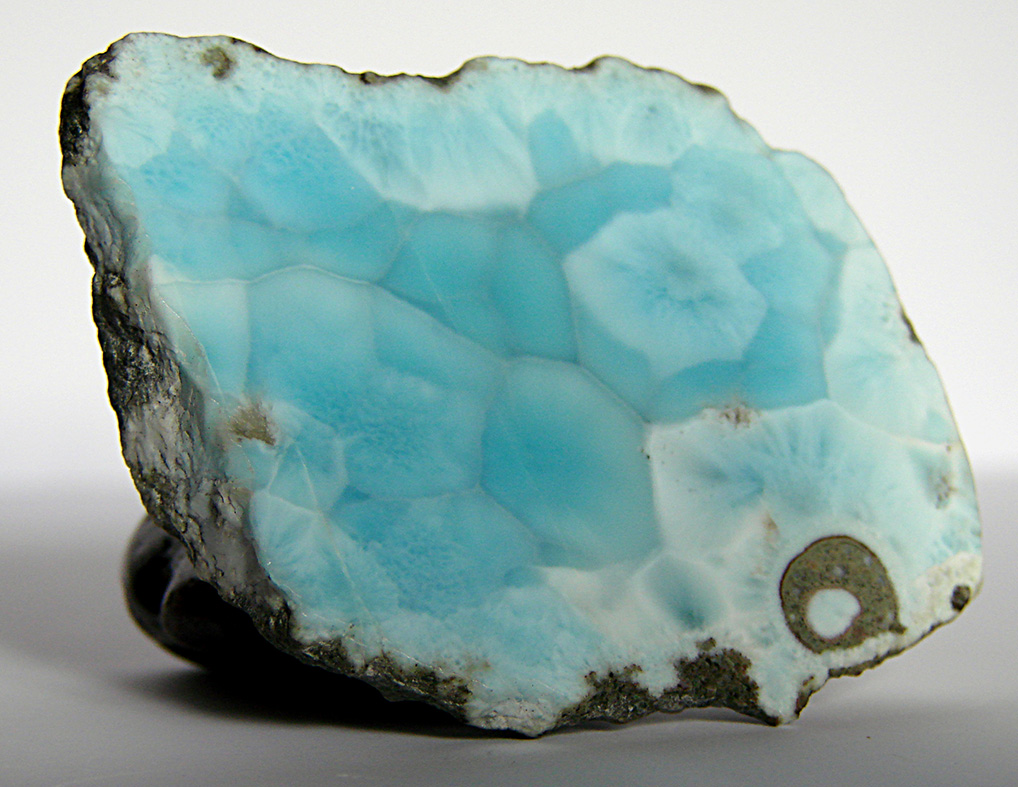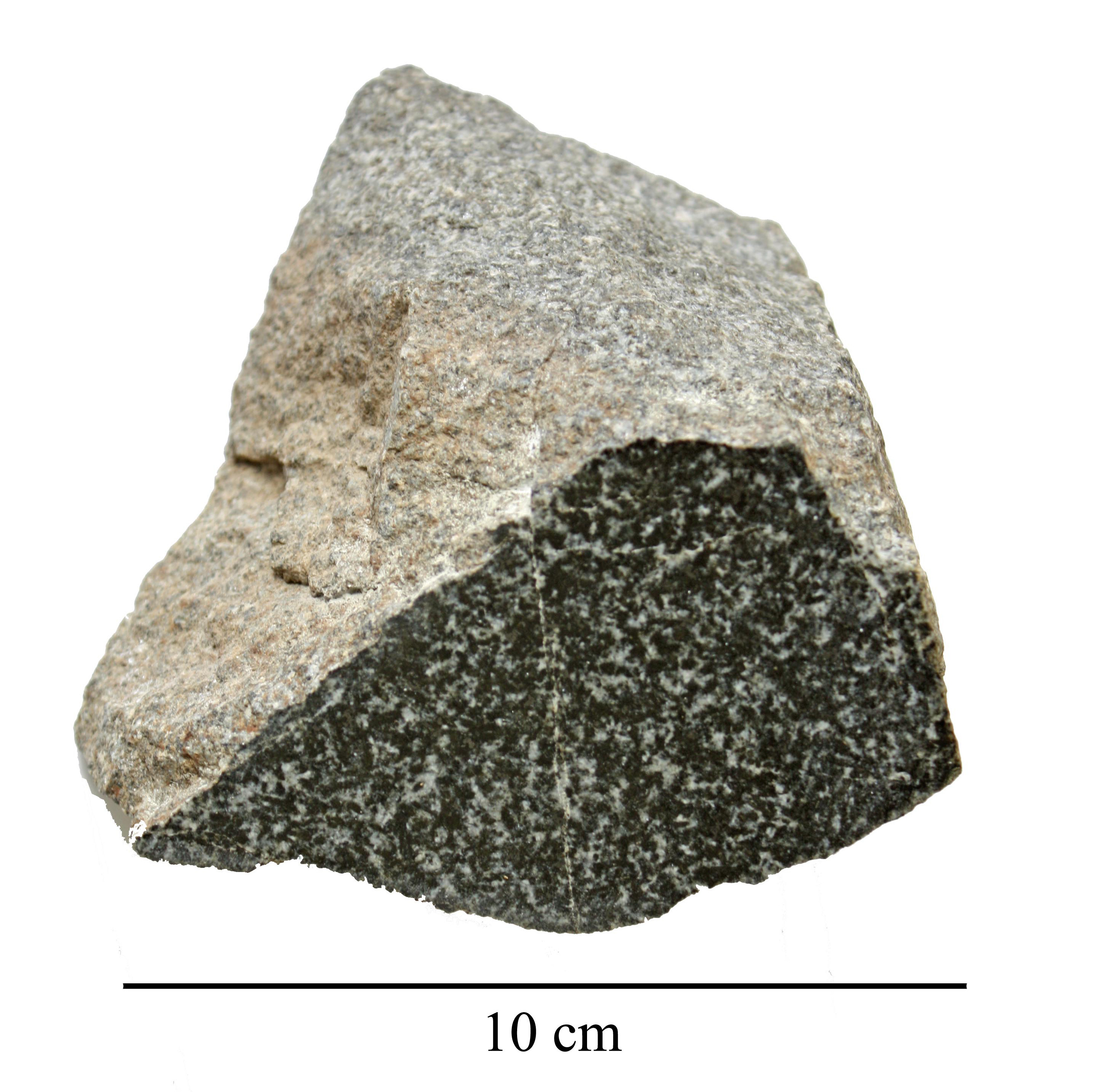|
Pectolite
Pectolite is a white to gray mineral, Na Ca2 Si3 O8(O H), a sodium calcium hydroxide inosilicate. It crystallizes in the triclinic system typically occurring in radiated or fibrous crystalline masses. It has a Mohs hardness of 4.5 to 5 and a specific gravity of 2.7 to 2.9. A highly sought-after variety known as larimar, is a pale to sky blue. There is also a whitish form of the mineral from Alaska that is sometimes marketed as 'Alaska jade'. Occurrence It was first described in 1828 at Mount Baldo, Trento Province, Italy, and named from the Greek ''pektos'' – "compacted" and ''lithos'' – "stone". It occurs as a primary mineral in nepheline syenites, within hydrothermal cavities in basalts and diabase and in serpentinites in association with zeolites, datolite, prehnite, calcite and serpentine. It is found in a wide variety of worldwide locations. See also *Serandite Serandite is a mineral with formula Na(Mn2+,Ca)2Si3O8(OH). The mineral was discovered in Guinea in 19 ... [...More Info...] [...Related Items...] OR: [Wikipedia] [Google] [Baidu] |
Larimar
Larimar is the tradename for a rare blue variety of the silicate mineral pectolite found only in Dominican Republic, around the city of Barahona. Its coloration varies from bluish white, light-blue, light-green, green-blue, turquoise blue, turquoise green, turquoise blue-green, deep green, dark green, to deep blue, dark blue and purple, violet and indigo and the larimar can come in many varieties and color mixes.Woodruff, R.E., 1986''Larimar, beautiful, blue and baffling.''''Lapidary Journal'', 39(10), pp.26-32. History Dominican Republic's Ministry of Mining records show that Father Miguel Domingo Fuertes Loren of the Barahona Parish requested permission on 22 November 1916 to explore and exploit the mine of a certain blue rock that he had discovered. Pectolites were not yet known in Dominican Republic, and the request was rejected. Miguel Méndez and Peace Corps volunteer Norman Rilling rediscovered Larimar in 1974 on a beach at the foot of the Bahoruco Mountain Range, t ... [...More Info...] [...Related Items...] OR: [Wikipedia] [Google] [Baidu] |
Inosilicate
Silicate minerals are rock-forming minerals made up of silicate groups. They are the largest and most important class of minerals and make up approximately 90 percent of Earth's crust. In mineralogy, the crystalline forms of silica (silicon dioxide, ) are usually considered to be Silicate mineral#Tectosilicates, tectosilicates, and they are classified as such in the Dana system (75.1). However, the Nickel-Strunz system classifies them as oxide minerals (4.DA). Silica is found in nature as the mineral quartz, and its polymorphism (materials science), polymorphs. On Earth, a wide variety of silicate minerals occur in an even wider range of combinations as a result of the processes that have been forming and re-working the crust for billions of years. These processes include partial melting, crystallization, fractionation, metamorphism, weathering, and diagenesis. Living organisms also contribute to this carbonate–silicate cycle, geologic cycle. For example, a type of plankton ... [...More Info...] [...Related Items...] OR: [Wikipedia] [Google] [Baidu] |
Diabase
Diabase (), also called dolerite () or microgabbro, is a mafic, holocrystalline, subvolcanic rock equivalent to volcanic basalt or plutonic gabbro. Diabase dikes and sills are typically shallow intrusive bodies and often exhibit fine-grained to aphanitic chilled margins which may contain tachylite (dark mafic glass). ''Diabase'' is the preferred name in North America, while ''dolerite'' is the preferred name in the rest of the English-speaking world, where sometimes the name ''diabase'' refers to altered dolerites and basalts. Some geologists prefer to avoid confusion by using the name ''microgabbro''. The name ''diabase'' comes from the French , and ultimately from the Greek 'act of crossing over, transition', whereas the name ''dolerite'' comes from the French , from the Greek 'deceitful, deceptive', because it was easily confused with diorite. Petrography Diabase normally has a fine but visible texture of euhedral lath-shaped plagioclase crystals (62%) set i ... [...More Info...] [...Related Items...] OR: [Wikipedia] [Google] [Baidu] |
Serpentinite
Serpentinite is a metamorphic rock composed predominantly of serpentine group minerals formed by serpentinization of mafic or ultramafic rocks. The ancient origin of the name is uncertain; it may be from the similarity of its texture or color to snake skin. Greek pharmacologist Pedanius Dioscorides, Dioscorides (AD 50) recommended this rock to prevent snakebite. Serpentinite has been called ''serpentine'' or ''serpentine rock'', particularly in older geological texts and in wider cultural settings.California Government Code § 425.2; ''see'' Most of the chemical reactions necessary to synthesize acetyl-CoA, essential to basic biochemical pathways of life, take place during serpentinization. Serpentinite thermal vents are therefore considered a candidate for the origin of life on Earth. Formation and mineralogy Serpentinite is formed by near to complete serpentinization of mafic or ultramafic rocks. Serpentinite is formed from mafic rock that is mineral hydration, hydrate ... [...More Info...] [...Related Items...] OR: [Wikipedia] [Google] [Baidu] |
Zeolite
Zeolites are a group of several microporous, crystalline aluminosilicate minerals commonly used as commercial adsorbents and catalysts. They mainly consist of silicon, aluminium, oxygen, and have the general formula ・y where is either a metal ion or H+. The term was originally coined in 1756 by Swedish mineralogist Axel Fredrik Cronstedt, who observed that rapidly heating a material, believed to have been stilbite, produced large amounts of steam from water that had been adsorbed by the material. Based on this, he called the material ''zeolite'', from the Greek , meaning "to boil" and , meaning "stone". Zeolites occur naturally, but are also produced industrially on a large scale. , 253 unique zeolite frameworks have been identified, and over 40 naturally occurring zeolite frameworks are known. Every new zeolite structure that is obtained is examined by the International Zeolite Association Structure Commission (IZA-SC) and receives a three-letter designation. Character ... [...More Info...] [...Related Items...] OR: [Wikipedia] [Google] [Baidu] |
Prehnite
Prehnite is an inosilicate of calcium and aluminium with the formula: Ca2Al(AlSi3O10)(OH)2 with limited Fe3+ substitutes for aluminium in the structure. Prehnite crystallizes in the orthorhombic crystal system, and most often forms as stalactitic, botryoidal, reniform or globular aggregates, with only just the crests of small crystals showing any faces, which are almost always curved or composite. Very rarely will it form distinct, well-individualized crystals showing a square-like cross-section, including those found at the Jeffrey Mine in Asbestos, Quebec, Canada. Prehnite is brittle with an uneven fracture and a vitreous to pearly luster. Its hardness is 6.5, its specific gravity is 2.80–2.95 and its color varies from light green to yellow, but also colorless, blue, pink or white. In April 2000, rare orange prehnite was discovered in the Kalahari Manganese Fields, South Africa. Prehnite is mostly translucent, and rarely transparent. Though not a zeolite, prehnite is found ... [...More Info...] [...Related Items...] OR: [Wikipedia] [Google] [Baidu] |
Datolite
Datolite is a calcium boron hydroxide nesosilicate, Ca B Si O4(O H). It was first observed by Jens Esmark in 1806, and named by him from δατεῖσθαι, "to divide," and λίθος, "stone," in allusion to the granular structure of the massive mineral. Datolite crystallizes in the monoclinic system forming prismatic crystals and nodular masses. The luster is vitreous and may be brown, yellow, light green or colorless. The Mohs hardness is 5.5 and the specific gravity is 2.8 - 3.0. The type localities are in the diabases of the Connecticut River valley and Arendal, Aust-Agder, Norway. Associated minerals include prehnite, danburite, babingtonite, epidote, native copper, calcite, quartz and zeolites. It is common in the copper deposits of the Lake Superior region of Michigan. It occurs as a secondary mineral in mafic igneous rocks often filling vesicles along with zeolites in basalt Basalt (; ) is an aphanite, aphanitic (fine-grained) extrusive i ... [...More Info...] [...Related Items...] OR: [Wikipedia] [Google] [Baidu] |
Hydrothermal
Hydrothermal circulation in its most general sense is the circulation of hot water (Ancient Greek ὕδωρ, ''water'',Liddell, H.G. & Scott, R. (1940). ''A Greek-English Lexicon. revised and augmented throughout by Sir Henry Stuart Jones. with the assistance of. Roderick McKenzie.'' Oxford: Clarendon Press. and θέρμη, ''heat'' ). Hydrothermal circulation occurs most often in the vicinity of sources of heat within the Earth's crust. In general, this occurs near volcanic activity, but can occur in the shallow to mid crust along deeply penetrating fault irregularities or in the deep crust related to the intrusion of granite, or as the result of orogeny or metamorphism. Hydrothermal circulation often results in hydrothermal mineral deposits. Seafloor hydrothermal circulation Hydrothermal circulation in the oceans is the passage of the water through mid-oceanic ridge systems. The term includes both the circulation of the well-known, high-temperature vent waters near the ridge c ... [...More Info...] [...Related Items...] OR: [Wikipedia] [Google] [Baidu] |
Calcite
Calcite is a Carbonate minerals, carbonate mineral and the most stable Polymorphism (materials science), polymorph of calcium carbonate (CaCO3). It is a very common mineral, particularly as a component of limestone. Calcite defines hardness 3 on the Mohs scale of mineral hardness, based on Scratch hardness, scratch hardness comparison. Large calcite crystals are used in optical equipment, and limestone composed mostly of calcite has numerous uses. Other polymorphs of calcium carbonate are the minerals aragonite and vaterite. Aragonite will change to calcite over timescales of days or less at temperatures exceeding 300 °C, and vaterite is even less stable. Etymology Calcite is derived from the German , a term from the 19th century that came from the Latin word for Lime (material), lime, (genitive ) with the suffix ''-ite'' used to name minerals. It is thus a Doublet (linguistics), doublet of the word ''wikt:chalk, chalk''. When applied by archaeology, archaeologists and ... [...More Info...] [...Related Items...] OR: [Wikipedia] [Google] [Baidu] |






